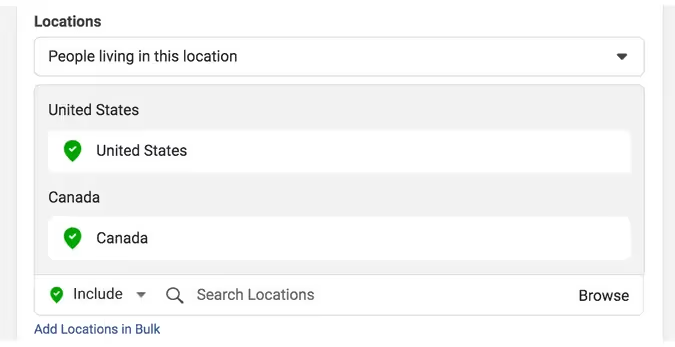
Conversation

🥳 Feedback Received!
Thanks for taking a moment to share your thoughts — it genuinely helps us make each chapter sharper.
What happens next:
- Your feedback goes straight to our product team.
- We’ll use it to refine lessons, clarify examples, and make the program even more useful.
Appreciate you helping make this program better for everyone.
Ready for your next challenge? 👇
Locations, Ages, Genders, and Language Targeting
Locations
Geography is the most significant demographic determinant of cost-per-impression. It's also the criterion that most limits your total audience volume.
So let's begin our ad set targeting with a discussion on geography! It's like you're back in high school!

First, note you'll probably want to select the "People who live in this location" dropdown option. This is in contrast to people who "are in" or "were recently in" your list of locations. Usually, the purpose of targeting by geography is to show your ad to people who have homes in that location and live there most of the year.
Second, know that countries split into three unofficial advertising "tiers:"
- Tier 1
- Australia
- Canada
- Denmark
- France
- Germany
- Ireland
- Netherlands
- New Zealand
- Norway
- Sweden
- Switzerland
- United Kingdom
- United States
- Tier 2
- Austria
- Belgium
- Czechia
- Estonia
- Hong Kong
- Ireland
- Israel
- Italy
- Poland
- Singapore
- Spain
- Tier 3
- Brazil
- China
- India
- South Korea
Tier 1
These are the most expensive countries to target. (They cost within 20% of each other.) They're expensive because their populations are more likely to buy higher-priced goods online. So they're most in demand by advertisers.
Of these countries, target all the ones your business can service. Then examine your ad performance to determine which performs poorly. Remove them.
Tier 2
This is the next tier down. Their populations are less likely to speak English fluently, which limits their appeal to most big-budget advertisers. Plus, they're less likely to have high purchasing power or are simply less likely to purchase goods online.
Only target these if you have a specific reason or feel like experimenting.
Tier 3
One tier down, you should only target these countries if you have a specific reason. And you generally only want to target their capital cities; avoid wasting money on the outskirts that are less likely to be able to afford your goods.
Remaining countries
The unlisted countries generally have negligibly small populations or are developing countries with negligible purchasing power, Internet access, and/or buying intent.
You can always begin by targeting countries you think are most likely to convert. This keeps your spending efficient while you test your initial set of ads. Over time, you'll add or remove countries based on the performance you see.
Retargeting
Don’t restrict by location if you’re creating a retargeting ad set (see Acquisition > Retargeting). We can check on low-converting locations later.
Gender and age
Unless you have a specific reason, avoid restricting by these criteria for your initial ad set tests. Instead, keep your targeting broad, then parse your ads' performance by the gender and age groups of the people who converted.
You should always let the data tell you who to target. Don't go on gut feel. See which demographics had the lowest CPA then refine your targeting from there.
That said, there is a rule of thumb: For most products that aren't explicitly targeting a younger demographic, targeting ages 22 to 45 keeps you within the bounds of those most likely to make Internet purchases.
Only break down ad sets by age (e.g., making one ad set targeting 22-30 year olds and another targeting 31-40 year olds) if showing them different copy and creatives makes sense. For most products, this won’t be the case.
Language
Assuming you're marketing in English, explicitly target English speakers if you're targeting countries where the majority doesn't speak English. (Or target English anyway, just to be safe at the expense of slightly narrowing your audience volume.)
For example, Germany has a lot of English speakers, but also a lot of people who don’t speak much English (who you wouldn’t want to target with ads). So it would make sense to specify English as a language if you’re targeting Germany.
If you are targeting an English-speaking country such as the US or the UK, leave this field blank. The odds are that nearly everyone seeing your ad can understand English well enough to get the gist and consider whether they want to convert.
If you do explicitly target "English," you're missing out on Facebook users who have their UI language set to something other than English but speak English. For example, a teenager (it’s always a teenager) may set their language to “Pirate”. Yes, that’s a real language on Facebook. (Arrreal language? OK. We’re done.)


